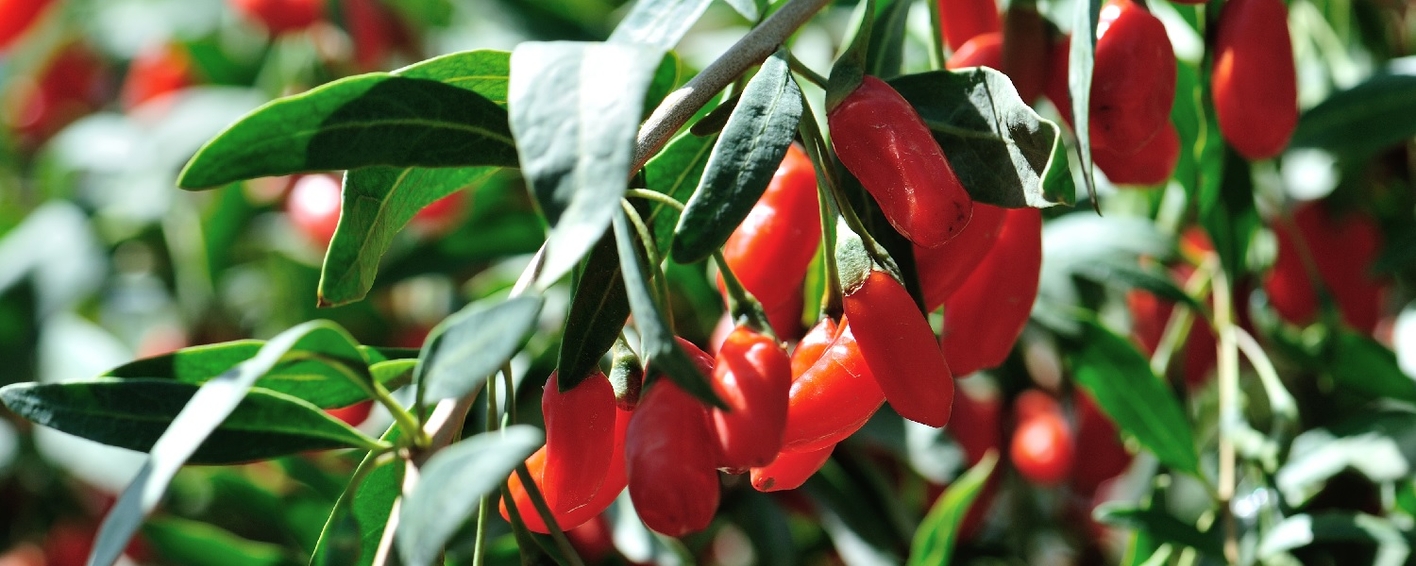
Recent research indicates that regular consumption of dried goji berries may help to prevent or delay the development of age-related macular degeneration (1).
Age-related macular degeneration (AMD) is a degenerative disease of the macula, often leading to progressive vision loss (2). AMD accounts for approximately 9% of all blindness worldwide and is the most common cause of blindness in developed countries (3). The cause of AMD is complex and multifactorial, involving demographic, genetic, molecular and environmental risk factors such as smoking, diet and sun exposure. The current treatment for intermediate stages of AMD uses dietary supplements containing vitamin C, vitamin E, zinc, copper, lutein and zeaxanthin. No known therapy has yet been shown to impact the prevention or the development of early stages of AMD (4).
Lutein, zeaxanthin, and the isomer meso-zeaxanthin are macular pigments that provide oxidative defence and filter damaging blue light in the macula. These pigments are found in plants as xanthophylls, and increased dietary intake is proposed to protect against the development and progression of AMD (5). The concentration of xanthophyll carotenoids in the retina can be measured non-invasively and are expressed as macular pigment optical density (MPOD) (6). Low MPOD levels indicate an increased risk of AMD (7).
Dietary lutein and zeaxanthin are found in red, yellow, or orange coloured fruits and vegetables, egg yolk, and in some green leafy vegetables (5,8). Dietary intakes of lutein and zeaxanthin are strongly associated with their serum levels, as well as with MPOD (9,10).
Goji berry (Lycium barbarum L. and L. chinense), also known as wolfberry or Go Chi Zi, has been used in traditional Chinese medicine for more than 2000 years (11). Goji berry is the highest known dietary source of zeaxanthin, containing a highly bioavailable form (dipalmitate). The intake of zeaxanthin dipalmitate extracts from goji berry increases plasma zeaxanthin to a greater extent than non-esterified zeaxanthin supplements (12,13). Other goji berry components such as taurine, vitamin C, zinc, and L. barbarum polysaccharides are beneficial in lowering oxidative stress and improving eye health (14,15).
The current randomised trial investigated the effects of daily intake of 1 serve (28 g, 1 handful) of dried goji berries on MPOD and skin carotenoid levels, compared to a commercially available supplement (lutein 6 mg; zeaxanthin 4 mg) among healthy middle-aged US adults (mean age 56 years) with no signs of early AMD. The results showed that a daily serve of goji berries, five times a week for 90 days, significantly increased MPOD in healthy adults. In contrast, individuals who consumed the commercial supplement for eye health over the same period did not show an increase (1).
The berries in the study were USDA-certified organic goji berries from the Ningxia region of northern China. A daily goji berry serving provided 28.8 mg of zeaxanthin, which is substantially higher than the 4 mg present in the supplement. The estimated content of lutein in a goji berry serve is 0.15 mg (See Table 1).
The study results are consistent with data from goji berry consumption in other study populations. A similar amount and intake period in a Chinese population at risk for intermediate AMD showed improved MPOD levels (16). In generally healthy but older individuals (aged 65 – 75 years), zeaxanthin (10 mg/day derived from goji berries) protected against macular hypopigmentation and drusen ![]() development (17). In people with low MPOD baseline levels, lutein and zeaxanthin supplementation improved MPOD (18). A meta-analysis regarding the effects of lutein, zeaxanthin, and meso-zeaxanthin supplementation found that the MPOD at baseline was inversely associated with macular responses, indicating that individuals with a relatively lower macular pigment status may receive more benefit with higher amounts of lutein or zeaxanthin (19).
development (17). In people with low MPOD baseline levels, lutein and zeaxanthin supplementation improved MPOD (18). A meta-analysis regarding the effects of lutein, zeaxanthin, and meso-zeaxanthin supplementation found that the MPOD at baseline was inversely associated with macular responses, indicating that individuals with a relatively lower macular pigment status may receive more benefit with higher amounts of lutein or zeaxanthin (19).
This is a small (n=28) preliminary study, nonetheless, the results are promising and warrant further investigation. It is worth noting that participants in the study had a reported dietary intake of lutein plus zeaxanthin (not including the intervention berries or supplement), of 3.1 and 1.9 mg/d in the goji berry and supplement groups, respectively. This might influence the overall macular health of the participants compared to the general public with lower intake, although baseline MPOD measures were similar between the goji berry and supplement groups. Three to five mg/d of lutein and zeaxanthin have been recommended to help support normal macular function. No recommended dietary allowance values are available (8).
Adding a small handful of dried goji berries to the daily diet is an easy and safe way to ensure adequate intake of zeaxanthin and lutein and can improve macular pigments of healthy individuals beyond taking high-dose nutritional supplements.
|
Nutritional and carotenoid properties in 1 serve (28 g) of goji berries (1) |
|
|
Nutritional Content |
Amount |
|
Calories |
95.1 Kcal |
|
Total Carbohydrate |
21.4 g |
|
Fat |
0.4 g |
|
Protein |
2.8 g |
|
Fibre |
2.7 g |
|
Total sugars |
15.1 g |
|
Carotenoids |
Amount |
|
Zeaxanthin |
28.8 mg |
|
β-carotene |
225 μg |
|
Trans β-carotene |
110 μg |
|
α-carotene |
13.8 μg |
|
Lycopene |
< 5.6 μg |
|
Lutein |
0.15 mg |





